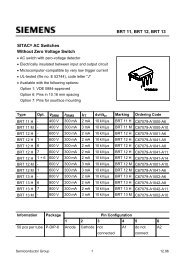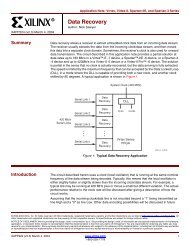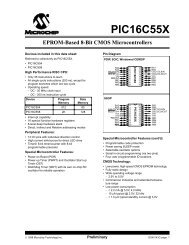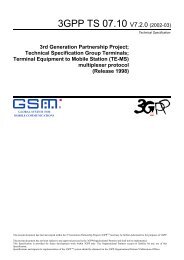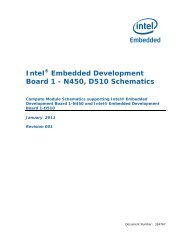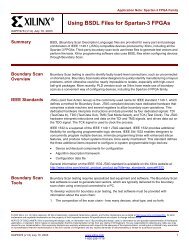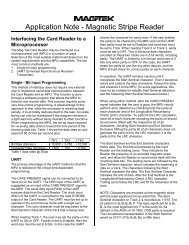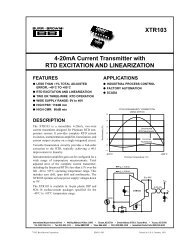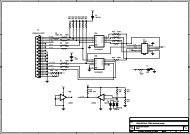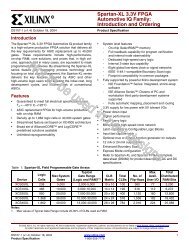6-PIN DIP ZERO-CROSS OPTOISOLATORS TRIAC DRIVER OUTPUT
6-PIN DIP ZERO-CROSS OPTOISOLATORS TRIAC DRIVER OUTPUT
6-PIN DIP ZERO-CROSS OPTOISOLATORS TRIAC DRIVER OUTPUT
You also want an ePaper? Increase the reach of your titles
YUMPU automatically turns print PDFs into web optimized ePapers that Google loves.
6-<strong>PIN</strong> <strong>DIP</strong> <strong>ZERO</strong>-<strong>CROSS</strong><br />
<strong>OPTOISOLATORS</strong> <strong>TRIAC</strong> <strong>DRIVER</strong> <strong>OUTPUT</strong><br />
(250/400 VOLT PEAK)<br />
MOC3031M MOC3032M MOC3033M MOC3041M MOC3042M MOC3043M<br />
DESCRIPTION<br />
The MOC303XM and MOC304XM devices consist of a AlGaAs<br />
infrared emitting diode optically coupled to a monolithic silicon<br />
detector performing the function of a zero voltage crossing bilateral<br />
triac driver.<br />
They are designed for use with a triac in the interface of logic<br />
systems to equipment powered from 115 VAC lines, such as<br />
teletypewriters, CRTs, solid-state relays, industrial controls,<br />
printers, motors, solenoids and consumer appliances, etc.<br />
6<br />
1<br />
6<br />
1<br />
FEATURES<br />
• Simplifies logic control of 115 VAC power<br />
• Zero voltage crossing<br />
• dv/dt of 2000 V/µs typical, 1000 V/µs guaranteed<br />
• VDE recognized (File # 94766)<br />
-ordering option V (e.g., MOC3043VM)<br />
6<br />
1<br />
ANODE 1<br />
CATHODE 2<br />
SCHEMATIC<br />
6 MAIN TERM.<br />
5 NC*<br />
APPLICATIONS<br />
• Solenoid/valve controls<br />
• Static power switches<br />
• Temperature controls<br />
• AC motor starters<br />
• Lighting controls<br />
• AC motor drives<br />
• E.M. contactors<br />
• Solid state relays<br />
N/C 3<br />
<strong>ZERO</strong><br />
<strong>CROSS</strong>ING<br />
CIRCUIT<br />
*DO NOT CONNECT<br />
(<strong>TRIAC</strong> SUBSTRATE)<br />
4 MAIN TERM.<br />
ABSOLUTE MAXIMUM RATINGS (T A = 25°C unless otherwise noted)<br />
Parameters Symbol Device Value Units<br />
TOTAL DEVICE<br />
Storage Temperature<br />
T STG All -40 to +150 °C<br />
Operating Temperature T OPR All -40 to +85 °C<br />
Lead Solder Temperature T SOL All 260 for 10 sec °C<br />
Junction Temperature Range T J All -40 to +100 °C<br />
Isolation Surge Voltage (1) (peak AC voltage, 60Hz, 1 sec duration) V ISO All 7500 Vac(pk)<br />
Total Device Power Dissipation @ 25°C<br />
250 mW<br />
P D<br />
All<br />
Derate above 25°C 2.94 mW/°C<br />
EMITTER<br />
Continuous Forward Current<br />
I F All 60 mA<br />
Reverse Voltage V R All 6 V<br />
Total Power Dissipation 25°C Ambient<br />
120 mW<br />
P D<br />
All<br />
Derate above 25°C 1.41 mW/°C<br />
DETECTOR MOC3031M/2M/3M 250<br />
V<br />
Off-State Output Terminal Voltage<br />
DRM MOC3041M/2M/3M 400<br />
Peak Repetitive Surge Current (PW = 100 µs, 120 pps) I TSM All 1 A<br />
Total Power Dissipation @ 25°C Ambient<br />
All 150 mW<br />
P<br />
Derate above 25°C D<br />
All 1.76 mW/°C<br />
Note<br />
1. Isolation surge voltage, V ISO , is an internal device dielectric breakdown rating. For this test, Pins 1 and 2 are common, and Pins 4,<br />
5 and 6 are common.<br />
V<br />
© 2001 Fairchild Semiconductor Corporation<br />
DS300256 8/06/01 1 OF 9 www.fairchildsemi.com
6-<strong>PIN</strong> <strong>DIP</strong> <strong>ZERO</strong>-<strong>CROSS</strong><br />
<strong>OPTOISOLATORS</strong> <strong>TRIAC</strong> <strong>DRIVER</strong> <strong>OUTPUT</strong><br />
(250/400 VOLT PEAK)<br />
MOC3031M MOC3032M MOC3033M MOC3041M MOC3042M MOC3043M<br />
ELECTRICAL CHARACTERISTICS (T A = 25°C Unless otherwise specified)<br />
INDIVIDUAL COMPONENT CHARACTERISTICS<br />
Parameters Test Conditions Symbol Device Min Typ Max Units<br />
EMITTER<br />
Input Forward Voltage<br />
I F = 30 mA V F All 1.25 1.5 V<br />
Reverse Leakage Current V R = 6 V I R All 0.01 100 µA<br />
DETECTOR<br />
Peak Blocking Current,Either Direction Rated V DRM , I F = 0 (note 1) I DRM1 All 100 nA<br />
Peak On-State Voltage,Either Direction I TM = 100 mA peak, I F = 0 V TM All 1.8 3 V<br />
Critical Rate of Rise of Off-State Voltage I F = 0 (figure 9, note 3) dv/dt All 1000 V/µs<br />
TRANSFER CHARACTERISTICS (T A = 25°C Unless otherwise specified.)<br />
DC Characteristics Test Conditions Symbol Device Min Typ Max Units<br />
MOC3031M/MOC3041M 15<br />
LED Trigger Current Main terminal voltage = 3V (note 2) I FT MOC3032M/MOC3042M 10 mA<br />
MOC3033M/MOC3043M 5<br />
Holding Current, Either Direction I H All 400 µA<br />
<strong>ZERO</strong> <strong>CROSS</strong>ING CHARACTERISTICS (T A = 25°C Unless otherwise specified.)<br />
Characteristics Test Conditions Symbol Device Min Typ Max Units<br />
Inhibit Voltage<br />
I F = rated I FT , MT1-MT2 voltage above<br />
which device will not trigger off-state<br />
V IH All 20 V<br />
Leakage in Inhibited State I F = rated I F , rated V DRM , off-state I DRM2 All 500 µA<br />
Note<br />
1. Test voltage must be applied within dv/dt rating.<br />
2. All devices are guaranteed to trigger at an I F value less than or equal to max I FT . Therefore, recommended operating I F lies between<br />
max I FT (15 mA for MOC3031M & MOC3041M, 10 mA for MOC3032M & MOC3042M, 5 mA for MOC3033M & MOC3043M) and<br />
absolute max I F (60 mA).<br />
3. This is static dv/dt. See Figure 9 for test circuit. Commutating dv/dt is a function of the load-driving thyristor(s) only.<br />
www.fairchildsemi.com 2 OF 9 8/06/01 DS300256
I FT , NORMALIZED<br />
I DRM , LEAKAGE CURRENT (nA)<br />
V F - FORWARD VOLTAGE (V)<br />
I TM , ON-STATE CURRENT (mA)<br />
6-<strong>PIN</strong> <strong>DIP</strong> <strong>ZERO</strong>-<strong>CROSS</strong><br />
<strong>OPTOISOLATORS</strong> <strong>TRIAC</strong> <strong>DRIVER</strong> <strong>OUTPUT</strong><br />
(250/400 VOLT PEAK)<br />
MOC3031M MOC3032M MOC3033M MOC3041M MOC3042M MOC3043M<br />
Figure 1. LED Forward Voltage vs. Forward Current<br />
Figure 2. On-State Characteristics<br />
1.6<br />
1.5<br />
800<br />
600<br />
I F = 30mA<br />
T A = 25 o C<br />
1.4<br />
400<br />
1.3<br />
200<br />
1.2<br />
T A = -40 o C<br />
0<br />
1.1<br />
T A = 25 o C<br />
-200<br />
1.0<br />
T A = 85 o C<br />
-400<br />
0.9<br />
-600<br />
0.8<br />
0.1 1 10 100<br />
I F - LED FORWARD CURRENT (mA)<br />
-800<br />
-4 -3 -2 -1 0 1 2 3 4<br />
V TM , ON-STATE VOLTAGE (VOLTS)<br />
1.3<br />
Figure 3. Trigger Current vs. Temperature<br />
10000<br />
Figure 4. Leakage Current, I DRM vs. Temperature<br />
1.2<br />
1000<br />
1.1<br />
100<br />
1.0<br />
10<br />
0.9<br />
1<br />
NORMALIZED TO<br />
T A = 25 o C<br />
0.8<br />
-40 -20 0 20 40 60 80 100<br />
T A , AMBIENT TEMPERATURE ( o C)<br />
0.1<br />
-40 -20 0 20 40 60 80 100<br />
T A , AMBIENT TEMPERATURE ( o C)<br />
DS300256 8/06/01 3 OF 9 www.fairchildsemi.com
I H , HOLDING CURRENT (NORMALIZED)<br />
V INH - NORMALIZED<br />
I DRM2 , NORMALIZED<br />
I FT , LED TRIGGER CURRENT (NORMALIZED)<br />
6-<strong>PIN</strong> <strong>DIP</strong> <strong>ZERO</strong>-<strong>CROSS</strong><br />
<strong>OPTOISOLATORS</strong> <strong>TRIAC</strong> <strong>DRIVER</strong> <strong>OUTPUT</strong><br />
(250/400 VOLT PEAK)<br />
MOC3031M MOC3032M MOC3033M MOC3041M MOC3042M MOC3043M<br />
Figure 5. I DRM2 - Leakage in Inhibit State vs. Temperature<br />
Figure 6. LED Current Required to Trigger vs. LED Pulse Width<br />
1.8<br />
1.6<br />
16<br />
14<br />
NORMALIZED TO<br />
PW IN >> 100 µs<br />
1.4<br />
12<br />
I F = RATED I FT<br />
1.2<br />
10<br />
1.0<br />
8<br />
0.8<br />
6<br />
0.6<br />
4<br />
0.4<br />
-40 -20 0 20 40 60 80 100<br />
T A , AMBIENT TEMPERATURE ( o C)<br />
2<br />
0<br />
1 10 100<br />
PW IN , LED TRIGGER PULSE WIDTH (µs)<br />
3.2<br />
Figure 7. Holding Current, I H vs. Temperature<br />
1.3<br />
Figure 8. Inhibit Voltage vs. Temperature<br />
2.8<br />
2.4<br />
1.2<br />
1.1<br />
NORMALIZED TO<br />
T A = 25 o C<br />
2.0<br />
1.6<br />
1.0<br />
1.2<br />
0.9<br />
0.8<br />
0.8<br />
0.4<br />
0.0<br />
-40 -20 0 20 40 60 80 100<br />
T A , AMBIENT TEMPERATURE ( o C)<br />
0.7<br />
-40 -20 0 20 40 60 80 100<br />
T A , AMBIENT TEMPERATURE ( o C)<br />
www.fairchildsemi.com 4 OF 9 8/06/01 DS300256
6-<strong>PIN</strong> <strong>DIP</strong> <strong>ZERO</strong>-<strong>CROSS</strong><br />
<strong>OPTOISOLATORS</strong> <strong>TRIAC</strong> <strong>DRIVER</strong> <strong>OUTPUT</strong><br />
(250/400 VOLT PEAK)<br />
MOC3031M MOC3032M MOC3033M MOC3041M MOC3042M MOC3043M<br />
+250 for MOC303XM<br />
+400 for MOC304XM<br />
Vdc<br />
0 VOLTS<br />
PULSE<br />
INPUT<br />
APPLIED VOLTAGE<br />
WAVEFORM<br />
dv/dt = 0.63 Vmax = 158<br />
τ RC<br />
τ RC<br />
0 VOLTS<br />
τ<br />
dv/dt = 0.63 Vmax = 252<br />
τ RC<br />
τ RC<br />
1. The mercury wetted relay provides a high speed repeated<br />
pulse to the D.U.T.<br />
2. 100x scope probes are used, to allow high speeds and<br />
voltages.<br />
R TEST<br />
R = 10 kΩ<br />
C TEST<br />
MERCURY<br />
WETTED<br />
X100<br />
RELAY<br />
SCOPE<br />
D.U.T. PROBE<br />
Figure 9. Static dv/dt Test Circuit<br />
V max = 250 V<br />
APPLIED VOLTAGE<br />
Vmax = 400 V<br />
158 V<br />
WAVEFORM<br />
252 V<br />
Figure 10. Static dv/dt Test Waveform<br />
(MOC3031M, MOC3032M, MOC3033M)<br />
3. The worst-case condition for static dv/dt is established by<br />
triggering the D.U.T. with a normal LED input current, then<br />
removing the current. The variable R TEST allows the dv/dt to<br />
be gradually increased until the D.U.T. continues to trigger in<br />
response to the applied voltage pulse, even after the LED<br />
current has been removed. The dv/dt is then decreased until<br />
the D.U.T. stops triggering. τ RC is measured at this point and<br />
recorded.<br />
Figure 11. Static dv/dt Test Waveform<br />
(MOC3041M, MOC3042M, MOC3043M)<br />
Typical circuit (Fig 12, 13) for use when hot line switching is required. In this circuit the “hot” side of the line is switched and the load<br />
connected to the cold or neutral side. The load may be connected to either the neutral or hot line.<br />
R in is calculated so that I F is equal to the rated I FT of the part, 5 mA for the MOC3033M and MOC3043M, 10 mA for the MOC3032M<br />
and MOC3042M, or 15 mA for the MOC3031M and MOC3041M. The 39 ohm resistor and 0.01 µF capacitor are for snubbing of the triac<br />
and may or may not be necessary depending upon the particular triac and load used.<br />
6<br />
180 Ω<br />
HOT<br />
6<br />
360 Ω<br />
HOT<br />
V CC<br />
R in 1<br />
2<br />
3<br />
MOC3031M<br />
MOC3032M<br />
MOC3033M<br />
5<br />
39 Ω<br />
*<br />
4 115 VAC<br />
V CC<br />
R in 1<br />
2<br />
3<br />
MOC3041M<br />
MOC3042M<br />
MOC3043M<br />
5<br />
39 Ω<br />
*<br />
4 240 VAC<br />
1 k<br />
0.01<br />
330<br />
0.01<br />
LOAD<br />
NEUTRAL<br />
LOAD<br />
NEUTRAL<br />
For highly inductive loads (power factor < 0.5), change this value to 360 ohms.<br />
*<br />
Figure 12. Hot-Line Switching Application Circuit<br />
(MOC3031M, MOC3032M, MOC3033M)<br />
For highly inductive loads (power factor < 0.5), change this value to 360 ohms.<br />
*<br />
Figure 13. Hot-Line Switching Application Circuit<br />
(MOC3041M, MOC3042M, MOC3043M)<br />
DS300256 8/06/01 5 OF 9 www.fairchildsemi.com
6-<strong>PIN</strong> <strong>DIP</strong> <strong>ZERO</strong>-<strong>CROSS</strong><br />
<strong>OPTOISOLATORS</strong> <strong>TRIAC</strong> <strong>DRIVER</strong> <strong>OUTPUT</strong><br />
(250/400 VOLT PEAK)<br />
MOC3031M MOC3032M MOC3033M MOC3041M MOC3042M MOC3043M<br />
115 VAC<br />
R1<br />
D1<br />
V CC<br />
R in<br />
1<br />
6<br />
2<br />
3<br />
MOC3031M<br />
MOC3032M<br />
MOC3033M<br />
5<br />
4<br />
180 Ω<br />
SCR<br />
SCR<br />
R2<br />
D2<br />
LOAD<br />
Figure 14. Inverse-Parallel SCR Driver Circuit<br />
(MOC3031M, MOC3032M, MOC3033M)<br />
Suggested method of firing two, back-to-back SCR’s with a Fairchild triac driver. Diodes can be 1N4001; resistors, R1 and R2, are<br />
optional 1 k ohm.<br />
240 VAC<br />
R1<br />
D1<br />
V CC<br />
R in<br />
1<br />
6<br />
2<br />
3<br />
MOC3041M<br />
MOC3042M<br />
MOC3043M<br />
5<br />
4<br />
360 Ω<br />
SCR<br />
SCR<br />
R2<br />
D2<br />
LOAD<br />
Figure 15. Inverse-Parallel SCR Driver Circuit<br />
(MOC3041M, MOC3042M, MOC3043M)<br />
Suggested method of firing two, back-to-back SCR’s with a Fairchild triac driver. Diodes can be 1N4001; resistors, R1 and R2, are<br />
optional 330 ohm.<br />
Note: This optoisolator should not be used to drive a load directly. It is intended to be a trigger device only.<br />
www.fairchildsemi.com 6 OF 9 8/06/01 DS300256
6-<strong>PIN</strong> <strong>DIP</strong> <strong>ZERO</strong>-<strong>CROSS</strong><br />
<strong>OPTOISOLATORS</strong> <strong>TRIAC</strong> <strong>DRIVER</strong> <strong>OUTPUT</strong><br />
(250/400 VOLT PEAK)<br />
MOC3031M MOC3032M MOC3033M MOC3041M MOC3042M MOC3043M<br />
Package Dimensions (Through Hole)<br />
Package Dimensions (Surface Mount)<br />
0.350 (8.89)<br />
0.320 (8.13)<br />
<strong>PIN</strong> 1<br />
ID.<br />
0.350 (8.89)<br />
0.320 (8.13)<br />
<strong>PIN</strong> 1<br />
ID.<br />
0.260 (6.60)<br />
0.240 (6.10)<br />
0.260 (6.60)<br />
0.240 (6.10)<br />
0.390 (9.90)<br />
0.332 (8.43)<br />
0.070 (1.77)<br />
0.040 (1.02)<br />
0.014 (0.36)<br />
0.010 (0.25)<br />
0.320 (8.13)<br />
0.070 (1.77)<br />
0.040 (1.02)<br />
0.014 (0.36)<br />
0.010 (0.25)<br />
0.320 (8.13)<br />
0.200 (5.08)<br />
0.115 (2.93)<br />
0.200 (5.08)<br />
0.115 (2.93)<br />
0.012 (0.30)<br />
0.008 (0.20)<br />
0.100 (2.54)<br />
0.015 (0.38)<br />
0.020 (0.50)<br />
0.016 (0.41)<br />
0.100 (2.54)<br />
15°<br />
0.012 (0.30)<br />
0.025 (0.63)<br />
0.020 (0.51)<br />
0.020 (0.50)<br />
0.016 (0.41)<br />
0.100 [2.54]<br />
0.035 (0.88)<br />
0.006 (0.16)<br />
Package Dimensions (0.4”Lead Spacing)<br />
0.350 (8.89)<br />
0.320 (8.13)<br />
<strong>PIN</strong> 1<br />
ID.<br />
Recommended Pad Layout for<br />
Surface Mount Leadform<br />
0.260 (6.60)<br />
0.240 (6.10)<br />
0.070 (1.78)<br />
0.060 (1.52)<br />
0.070 (1.77)<br />
0.040 (1.02)<br />
0.014 (0.36)<br />
0.010 (0.25)<br />
0.425 (10.79)<br />
0.305 (7.75)<br />
0.100 (2.54)<br />
0.030 (0.76)<br />
0.200 (5.08)<br />
0.115 (2.93)<br />
0.100 (2.54)<br />
0.015 (0.38)<br />
0.020 (0.50)<br />
0.016 (0.41)<br />
0.100 [2.54]<br />
0.012 (0.30)<br />
0.008 (0.21)<br />
0.425 (10.80)<br />
0.400 (10.16)<br />
NOTE<br />
All dimensions are in inches (millimeters)<br />
DS300256 8/06/01 7 OF 9 www.fairchildsemi.com
ORDERING INFORMATION<br />
6-<strong>PIN</strong> <strong>DIP</strong> <strong>ZERO</strong>-<strong>CROSS</strong><br />
<strong>OPTOISOLATORS</strong> <strong>TRIAC</strong> <strong>DRIVER</strong> <strong>OUTPUT</strong><br />
(250/400 VOLT PEAK)<br />
MOC3031M MOC3032M MOC3033M MOC3041M MOC3042M MOC3043M<br />
Option Order Entry Identifier Description<br />
S S Surface Mount Lead Bend<br />
SR2 SR2 Surface Mount; Tape and reel<br />
T T 0.4” Lead Spacing<br />
V V VDE 0884<br />
TV TV VDE 0884, 0.4” Lead Spacing<br />
SV SV VDE 0884, Surface Mount<br />
SR2V SR2V VDE 0884, Surface Mount, Tape & Reel<br />
Carrier Tape Specifications (“D” Taping Orientation)<br />
4.5 ± 0.20<br />
0.30 MAX<br />
4.0 ± 0.1<br />
12.0 ± 0.1<br />
2.0 ± 0.05<br />
Ø1.5 MIN<br />
1.75 ± 0.10<br />
21.0 ± 0.1<br />
11.5 ± 1.0<br />
24.0 ± 0.3<br />
9.1 ± 0.20<br />
0.1 MAX 10.1 ± 0.20<br />
Ø1.5 ± 0.1/-0<br />
User Direction of Feed<br />
NOTE<br />
All dimensions are in inches (millimeters)<br />
www.fairchildsemi.com 8 OF 9 8/06/01 DS300256
6-<strong>PIN</strong> <strong>DIP</strong> <strong>ZERO</strong>-<strong>CROSS</strong><br />
<strong>OPTOISOLATORS</strong> <strong>TRIAC</strong> <strong>DRIVER</strong> <strong>OUTPUT</strong><br />
(250/400 VOLT PEAK)<br />
MOC3031M MOC3032M MOC3033M MOC3041M MOC3042M MOC3043M<br />
DISCLAIMER<br />
FAIRCHILD SEMICONDUCTOR RESERVES THE THE RIGHT TO MAKE CHANGES WITHOUT FURTHER NOTICE<br />
TO ANY PRODUCTS HEREIN TO IMPROVE RELIABILITY, FUNCTION OR DESIGN. FAIRCHILD DOES NOT<br />
ASSUME ANY LIABILITY ARISING OUT OF THE APPLICATION OR USE OF ANY PRODUCT OR CIRCUIT<br />
DESCRIBED HEREIN; NEITHER DOES IT CONVEY ANY LICENSE UNDER ITS PATENT RIGHTS, NOR THE<br />
RIGHTS OF OTHERS.<br />
LIFE SUPPORT POLICY<br />
FAIRCHILD’S PRODUCTS ARE NOT AUTHORIZED FOR USE AS CRITICAL COMPONENTS IN LIFE SUPPORT<br />
DEVICES OR SYSTEMS WITHOUT THE EXPRESS WRITTEN APPROVAL OF THE PRESIDENT OF FAIRCHILD<br />
SEMICONDUCTOR CORPORATION. As used herein:<br />
1. Life support devices or systems are devices or<br />
systems which, (a) are intended for surgical<br />
implant into the body,or (b) support or sustain life,<br />
and (c) whose failure to perform when properly<br />
used in accordance with instructions for use provided<br />
in labeling, can be reasonably expected to result in a<br />
significant injury of the user.<br />
2. A critical component in any component of a life support<br />
device or system whose failure to perform can be<br />
reasonably expected to cause the failure of the life<br />
support device or system, or to affect its safety or<br />
effectiveness.<br />
DS300256 8/06/01 9 OF 9 www.fairchildsemi.com
This datasheet has been download from:<br />
www.datasheetcatalog.com<br />
Datasheets for electronics components.



